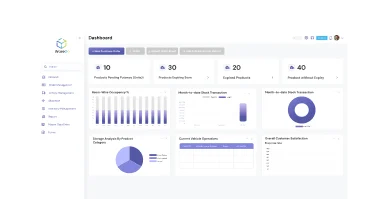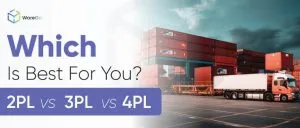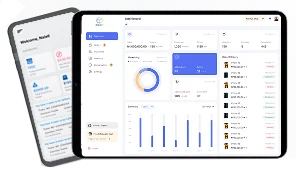
A 3PL Warehouse Management System (WMS) is specialized software for third-party logistics providers. A WMS for 3PL is designed to cater to multi-client operations at scale, unlike the standard WMS that mostly manages a single business at a dedicated warehouse and with a linear workflow.
Modern supply chains rely on speedy, accurate, and risk-efficient operations at scale. Third-party logistics fulfill these needs and go beyond by letting businesses avoid the pressure of having self-owned warehouses, infrastructure, or labor. And to stay efficient with multi-client operations, third-party logistics providers use 3PL WMS.
Here is an extensive guide on what is 3PL warehouse management system, how it works, and what it takes to integrate a WMS in 3PL operations.
Table of Contents
What is a 3PL WMS?
A 3PL Warehouse System is specifically built for 3rd party logistics and multi-client operations. It helps manage the receiving, storage, picking, packing, shipping, and returns of goods in the warehouse for multiple clients and brands. Unlike generic systems, a WMS for 3PL provides client-specific visibility and an event-driven billing engine to charge for storage, handling, picks, value-added services, and projects.
Multi-client warehouse operations are complex, as each client has separate SLAs, routing rules, labeling, and charge models. A purpose-built WMS for 3PL centralizes all execution, improves cycle time, and closes revenue leakage from manual billing.
How Does a 3PL WMS Work?
A 3PL WMS sits between the demand stack (ERP, eCommerce platforms, marketplaces, and retailer-compliant data exchanges) and the physical execution layer (people, RF devices, automation, and carriers).
A 3PL WMS is used to maintain the real-time state of inventory, orders, tasks, and shipments for each client, then drive the workflows that keep that state correct. Think of a 3PL WMS as a systematic, interconnected system. Every scan, movement, exception, or label print in a warehouse is considered as an event that updates the system’s state, triggers the next task, and creates a billable record tied to a client contract when applicable.

Here are the core functions and components that 3PL WMS covers:
Integrations & Data Model
The WMS syncs orders, inventory, shipments, and invoices through APIs, webhooks, native cart connectors, and carrier label/manifest links. Retail and wholesale inventory management system flows use structured messages that are mapped by the system to objects like orders, shipments, adjustments, and invoices.
The system uses idempotency to prevent duplicates, queued retries for transient errors, and reconciled reports for surface-level mismatches. The data model clearly scopes every record to a client, site, location, item, unit of measure, and license plate (pallet/carton/tote). Fast paths update eCommerce and inventory in seconds to avoid oversells and mis-allocations.
Inbound & Putaway
Receiving starts with a planned shipment or purchase order. The inbound staff checks what arrived against what was planned, records the condition, and assigns a license plate to each handling unit. Discrepancies are logged without stopping the dock.
WMS issues directed putaway to send items to the right slot based on velocity, size/weight, temperature or hazard rules, and current capacity. Operators confirm goods movement on handhelds; each scan updates the warehouse map.
Automated putaway shortens dock-to-stock time, minimizes travel, and removes human decision debt from the aisle that ultimately gets businesses better traceability across the warehouse workflows.
Storage, Control, & Replenishment
After putaway, inventory is managed under rotation policies such as first-in-first-out or first-expire-first-out enforced by the inventory management software. Lots, serials, catch weight, and quarantine states are tracked at the license-plate level where needed.
Zones reflect environmental and handling constraints, and locations carry capacity and dimension attributes to prevent mis-stows. The WMS schedules cycle counts by risk and value to prioritize high-velocity or error-prone areas and keeps perpetual inventory aligned without shutting an aisle.
Replenishment protects the forward pick face: min/max thresholds, forecasted demand, and wave plans trigger tasks that backfill pick slots from reserve before they run dry. In third-party logistics, the system prevents cross-client contamination and respects ownership even when two clients carry the same SKU code by using client-scoped item identities.
Order Management & Outbound
Order orchestration starts with allocation. The WMS reserves inventory by client, channel, SLA, and carrier cutoff, honoring holds and substitutions where contracted. It then selects the right picking strategy for the order mix.
Batch and cluster picking reduce travel for small, multi-line direct-to-consumer orders. Zone and wave picking suit large wholesale runs. Automation can feed goods-to-person workstations or guide operators with put-to-light and voice. Verification happens at the point of pick—with scans or weight checks—to stop errors early.
At pack-out, cartonization chooses the right packaging based on product dimensions, fragility, and carrier rules, while rate shopping selects a service that meets delivery promises at the lowest landed cost. The system prints compliant labels and manifests, closes out trailers or parcel pickups, and pushes tracking and shipment confirmations back to the source systems and the client portal.
Because picking usually consumes the most labor time, orchestration focuses on travel reduction, clean verification, and balanced workloads across people and zones to improve throughput without overtime.
Returns & Disposition
The WMS treats returns as first-class work, not a side loop. Each return is identified against an order or authorization, inspected, and graded. Items suitable for resale are restocked with their condition and lot/serial intact; others are routed to refurbish, quarantine, or scrap with reasons captured for analytics. Those reasons matter.
If the data shows damage at a specific pack station, you fix packaging. If it shows frequent wrong-item picks on a family of SKUs, you adjust slotting or improve pick prompts. Clean returns workflows protect inventory accuracy and reduce write-offs.
Client Visibility & 3PL Billing
Every client gets a real-time view: receipts, on-hand inventory by location and status, open orders, exceptions, shipped orders with tracking, and financials tied to their contract. The billing engine converts operational events into charges with storage snapshots, handling, picks, packs, special projects, and value-added services attached for evidence.
Disputes drop when every fee links to a timestamp, a user, and a scan. Invoices export to the client’s financial system, and revenue recognition aligns to your accounting cadence. This is the core difference between a single-owner WMS and a 3PL platform: the same scans that keep operations accurate also guarantee you get paid for the work you performed.
A focused walkthrough of receiving, putaway, picking, packing, shipping, returns, and invoicing. Learn exactly how WareGo fits your operation.
Request WMS DemoKey Features of a 3PL WMS
Read this like a feature brief: what it is, how it works, and why it matters in day-to-day operations.

Multi-Client Isolation
Run multiple clients in one facility without crosstalk. The system scopes every record—items, locations, tasks, users, reports, and rate cards—to a specific client and applies permission sets accordingly. You get clean audits, faster onboarding with reusable templates, and lower risk on SLAs and chargebacks.
Inventory Precision & Control
Keep inventory accurate and auditable across eaches, cases, and pallets. The WMS assigns a unique license plate to every handling unit, tracks lots, serials, status, and catch-weight where relevant, and enforces risk-based cycle counts. Accuracy goes up, shrinkage goes down, and available-to-promise stays reliable across channels.
Order Orchestration
Ship on time at the lowest feasible cost. The system allocates inventory by client, channel, and cutoff rules; chooses the right pick method for the order mix; and balances workload across zones. Travel falls, mis-picks drop, and carrier cutoffs stop being fire drills.
Cartonization & Rate Optimization
Remove guesswork at the pack station. The WMS calculates the right packaging from product dimensions and fragility, then selects a carrier service that meets the promise at the lowest landed cost and prints compliant labels and manifests. Packing materials and freight spending tighten without manual decisions.
Client Portal & Self-Service
Give every client real-time visibility and control. Dashboards show receipts, on-hand by status, open orders, exceptions, shipped orders with tracking, and current invoices; clients can download documents and request projects without email chains. Support load falls, QBRs get easier, and retention improves.
3PL Billing & Revenue Assurance
Capture every contracted charge automatically. Operational events—storage snapshots, handling, picks, packs, projects, and value-added services—become billable line items with time, user, and scan evidence. Disputes shrink, cash collection speeds up, and leakage from manual billing disappears.
Integrations Across ERP, eCommerce, & Transportation
Keep systems in sync from order to cash. The WMS exchanges data with ERPs, online stores and marketplaces, retailer gateways, and carrier/TMS systems via APIs and webhooks. It handles retries, idempotency, and reconciliation so upstream and downstream counts match. Oversells drop, compliance improves, and exceptions are easier to resolve.
Reporting & Analytics
Operate on KPIs, not anecdotes. Real-time dashboards track inventory accuracy, dock-to-stock, pick productivity, order cycle time, chargebacks, and billing capture; exports and APIs power client QBRs and your data warehouse. You get targeted improvements and a clear profitability view by client and site.
Security & Compliance
Protect client data and contracts. Role-based access, SSO, audit logs, encryption at rest and in transit, and sensible retention policies keep auditors happy. Risk falls, and access management gets simpler at scale.
Automation-Ready
Scale without linear headcount. Standard interfaces connect the WMS to conveyors, AMRs, put-to-light, weigh/scan/dimensioners, and warehouse control/execution systems. Because picking is the biggest labor pool, automation here compounds savings and stabilizes throughput during peaks.
Benefits of Using 3PL Warehouse Management Software
This is how a 3PL WMS shows up on the P&L: higher accuracy, faster cycles, captured revenue, lower cost-to-serve, and a better client experience.

Higher Accuracy & Fewer Chargebacks
Receiving, location control, and scan verification keep system and physical counts aligned. Retailer-compliant labels and shipment confirmations reduce penalties. Root-cause analytics surface repeat issues so you fix them once and stop paying for the same mistake.
Faster Cycle Times & Higher Throughput
Directed putaway, the right pick strategy, and task interleaving cut travel and idle time. Cartonization and rate selection remove slow decisions at pack and ship. Dock-to-stock and order cycle time come down without overtime.
Captured Revenue & Cleaner Invoicing
Event-driven billing closes gaps on storage, handling, and value-added services. Each fee links back to scans and timestamps, so invoices reconcile quickly and cash flow is more predictable.
Lower Cost-to-Serve
When waves match the order mix and packaging is right-sized, you spend less on labor and materials. Travel reduction and verification at the source deliver outsized savings because picking consumes the most effort in most warehouses.
Better Client Experience
Clients see live truth—inventory, orders, exceptions, tracking, and invoices—in one portal. Fewer status emails, faster resolutions, and cleaner QBRs translate to higher trust and longer contracts.
3PL vs. Traditional Systems: What’s Different & Why It Matters
A generic WMS and an ERP can both track inventory. A specialized 3PL WMS is built to run multi-client operations, expose a client portal, and convert warehouse work into billable charges. The table shows where each option fits.
Dimension | Generic / Entry-Level WMS | ERP | Specialized 3PL WMS |
| Operating model | Single owner, one rulebook | Financial system of record with basic inventory | Multi-client by design with isolated data and rules |
| Client billing | Usually manual or custom | Not built for event-based warehouse billing | Native event-driven billing for storage, handling, picks, & VAS |
| Client visibility | Internal screens and reports | Finance and planning view | Real-time client portal for inventory, orders, exceptions, & invoices |
| Retail & marketplace flows | Often add-ons | External connectors | Managed retail compliance & eCommerce connectors |
| Transportation | Basic label printing | Depends on add-ons | Integrated labels, manifests, rate selection, pickup close-out |
| Multi-site scale | Varies by tier | Financially multi-company | Network-aware multi-warehouse with shared templates |
| Automation hooks | Limited | Not core | Standard interfaces for WES/WCS, AMRs, & put-to-light |
| Admin & onboarding | Manual setup per brand | Formal change cycles | Templates for client onboarding, roles, and rate cards |
| Primary fit | One brand, simple rules | Accounting and planning backbone | 3rd-party logistics and brands outsourcing fulfillment |
If you run a single brand with simple flows, a generic WMS or ERP extension might suffice. The moment you add multiple clients, channel-specific SLAs, or charge models, the admin overhead and billing risk spike. A 3PL WMS removes the workarounds: client isolation is native, billing is event-based, and the portal reduces support load. Choose the platform that matches your operating model, not just today’s features.
Have integration questions. Ask live about ERP, eCommerce, retail compliance, and carrier setups. Get straight answers, not slides.
Chat with WareGoIndustries That Use a WMS for 3PL
Many industries handle multi-client or multi-brand operations, which makes 3PL warehouse software a necessity for them to meet the optimal turnaround and accuracy goals.

eCommerce & Omnichannel Retail
Mixed order profiles, frequent promotions, and high returns need fast allocation, the right pick method per wave, and immediate confirmations back to stores and marketplaces.
Consumer Packaged Goods
Case and pallet flows run alongside each other. Promotional spikes and labeling rules make slotting, cartonization, and retail compliance non-negotiable.
Pharma & Healthcare
FEFO, temperature capture, lot and serial traceability, and audit-ready histories are enforced at the system level to support inspections and recalls.
Apparel & Footwear
Style-color-size variants and value-added services like ticketing or rebagging benefit from cluster picking, clear QC prompts, and reason-coded returns.
Industrial & B2B Distribution
Heavy items, documentation requirements, and cross-dock moves call for appointment control, ASN accuracy, and clean handoffs to transportation.
3PL Startups & Regional Providers
Template rate cards, permission presets, and prebuilt connectors compress onboarding time and bring new clients to revenue faster.
Key Integrations to WMS for 3PL: ERP, eCommerce, Transportation
Here are the major software or tools that can be integrated into 3PL software to extend operational efficiency and top-notch connectivity to the entire supply chain ecosystem.

ERP
The WMS is the operational source of truth; the ERP remains the financial system of record. Item masters, purchase and sales orders, inventory adjustments, and invoices move between the two on a defined cadence. Decide which system owns which field, how conflicts are resolved, and how you reconcile when counts diverge.
eCommerce & Marketplaces
Native connectors keep orders, inventory, and shipment confirmations current. Set expectations on ingest speed, throttling, and error handling. For high-volume peaks, confirm that backpressure does not delay confirmations or oversell inventory.
Retail & Wholesale Exchanges
Structured documents carry shipping orders, confirmations, stock transfers, receipts, adjustments, advance ship notices, and invoicing. Your WMS should map these messages to internal objects, validate content before execution, and surface clear exception queues when a partner sends bad data.
Transportation
Parcel labels, manifests, and pickup close-outs must be produced on time and in the right format. For LTL/TL, plan the handoff to your TMS. Rate selection should balance promised delivery dates with cost, not just pick the cheapest label.
How Much Does a 3PL WMS Cost?
Licensing and implementation vary by user count, order volume, number of sites, integration scope, and automation. Use the table as a budgeting scaffold, then model cost per order against expected gains.
Cost area | What’s included | Directional guidance |
| Platform license (cloud) | Base platform plus user and/or order tiers | Recurring subscription; scales with sites, users, and volume. Small teams start low; multi-site and advanced modules raise the monthly bill. |
| Perpetual/on-prem license | One-time license per site | Higher upfront; ongoing maintenance. Suits IT-controlled environments or strict data requirements. |
| Integrations | ERP, carts/marketplaces, retail exchanges, carriers/TMS | Packaged connectors reduce effort. Custom mappings, change management, and testing drive costs more than the connector itself. |
| Implementation & training | Discovery, configuration, test cycles, role-based training, pilot/hypercare | Ranges from a simple single-site rollout to multi-site programs with heavy data cleanup and automation. Scope decides the bracket. |
| Hardware & infrastructure | RF scanners, industrial printers, Wi-Fi survey, label stock, workstations | One-time with periodic replacement; rugged devices cost more but last longer under warehouse conditions. |
| Support & SLAs | Helpdesk, upgrades, uptime guarantees | Tiered by response time and coverage window. Higher tiers matter if you run around the clock. |
| Ongoing change | Enhancements and process updates | Budget a rolling percentage of license for continuous improvement and new client onboarding. |
Subscription vs license is not purely a cost decision; it affects upgrade cadence, internal IT load, and time to value. Integrations are often underestimated; mapping, error handling, and end-to-end testing take longer than standing up the connector. Hardware is a rounding error for many programs, but bad scanners and weak Wi-Fi will sink adoption. Treat implementation as an operations project with clear success metrics, not just an IT install.
Cost-Per-Order Model
Build a simple before/after model: labor minutes by step, packaging materials, chargebacks, and freight surcharges versus expected improvements in travel, verification, and cartonization. Picking usually dominates the labor line, so wins there drive most of the payback.
For a more extensive and component-focused breakdown, review our warehouse management system cost guide.
Stand up a limited scope with real orders and measured KPIs. Prove accuracy, speed, and billing capture before broad rollout.
Start Pilot DemoChoosing the Right WMS for 3PL Operations
Start with your operating model. List clients, channels, order profiles, compliance requirements, and the exceptions that burn time. Pick scenarios that reflect your real peak day and ask vendors to run them live. You want to see allocation against carrier cutoffs, mixed D2C and retail waves, project work for value-added services, and a full billing preview with evidence.
Confirm how the platform isolates clients, models rate cards, and turns events into billable lines. Ask who owns each integration, how retries and duplicates are handled, and how reconciliation is reported. Check practical limits: concurrent scans, orders per hour, SKU count, and users. If you plan automation, verify interfaces to WES/WCS and ask for references with similar equipment.
Security, reliability, and roadmap matter. Roles, SSO, audit logs, and data retention reduce risk. Uptime SLAs and incident response give you a safety net. A credible roadmap on analytics, labor planning, and automation tells you whether the platform will keep up with your growth.
ROI & KPI Framework for 3PL WMS
Track a small set of metrics from day one and review them weekly in the first month, then monthly.
Inventory accuracy shows whether receiving and location control are working. Dock-to-stock and order cycle time reveal flow health. Lines or units per labor hour show true productivity. Chargeback rate signals retail compliance.
Billing capture rate and dispute cycle time confirm whether you are getting paid for the work performed. Cost per order rolls everything into one number that finance cares about. Improve the upstream steps first—receiving accuracy and slotting—then tune pick strategy and pack decisions.
Is a 3PL WMS Right for You?
Adopt a specialized 3PL WMS if you operate for multiple clients, serve both D2C and retail, or lose revenue to manual billing. The platform should prove three things in a pilot: better accuracy and speed on the floor, auditable billing that survives scrutiny, and lower cost per order under peak load.
If you run a single brand with simple flows, a generic WMS or ERP extension may be sufficient. Match the system to the complexity you actually run, not the features you hope to use later.
For one-on-one, specialized consultancy on warehouse management software get in touch with our in-house experts at WareGo.
Bring your client mix, SLAs, and exceptions. We map use cases to configuration and show the path to measurable throughput gains using 3PL WMS.
Talk to a WMS ExpertFAQs
What is a 3PL warehouse management system?
It’s software that runs multi-client warehousing end to end: receiving, storage, picking, packing, shipping, returns, client portals, and event-based billing. If you wonder what is 3PL warehouse system, think “execution plus billing” built for outsourced fulfillment, not single-brand operations.
How does a 3PL WMS differ from a regular warehouse system?
A regular WMS suits one owner. A 3PL WMS isolates clients, enforces client-specific rules, and turns activities into auditable charges. If you’re asking what is 3PL WMS versus generic WMS, the answer is multi-tenant control plus native revenue capture.
What are the main features of a 3PL WMS?
Core capabilities include client isolation, license-plate tracking, SLA-aware allocation, wave and cluster picking, cartonization, rate optimization, client portals, and automated billing. A strong WMS for 3PL also offers robust APIs, retailer-compliant data exchanges, and carrier label and manifest generation.
Who needs a 3PL system?
3PL providers, brands outsourcing fulfillment, and omni-channel operations with retail compliance or heavy seasonality. If spreadsheets, chargebacks, or missed fees keep appearing, 3PL warehouse software centralizes execution, visibility, and billing so you scale without uncontrolled labor or revenue leakage.
What are the benefits of using a 3PL WMS?
Higher inventory accuracy, faster dock-to-stock, better pick productivity, fewer chargebacks, and captured revenue from storage, handling, and VAS. For 3rd party logistics, the payoff is lower cost-per-order, cleaner invoices, and happier clients with self-serve visibility.
How much does a 3PL WMS cost?
Budgets mix subscriptions or licenses, integrations, implementation, and devices. Model cost-per-order against gains in travel reduction, accuracy, and billing capture. When you assess the value of 3PL software, the ROI hinges on pick productivity and avoided chargebacks.
Which integrations matter most in a 3PL WMS?
ERP sync for masters and financials, eCommerce and marketplace connectors for real-time orders, retailer-compliant exchanges for compliance, and carrier APIs for labels and manifests. Frictionless integrations turn 3PL WMS from a database into a live control layer across systems.
How long does 3PL WMS implementation take, and what drives the timeline?
Single-site, light-integration projects can pilot in weeks; multi-site projects with retail compliance, automation, and complex billing take longer. Data hygiene, testing discipline, and change management decide speed. A well-scoped WMS for 3PL rolls out in phased waves to de-risk go-live.





